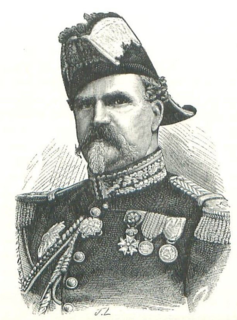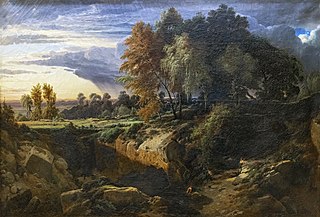
Jacques Ignace Hittorff or, in German, Jakob Ignaz Hittorff was a German-born French architect who combined advanced structural use of new materials, notably cast iron, with conservative Beaux-Arts classicism in a career that spanned the decades from the Restoration to the Second Empire.

Le Louvre des Antiquaires is a historic structure in Paris, France, on the Place du Palais-Royal. The building was designed by Alfred Armand and was constructed in 1855 as a hotel, the Grand Hôtel du Louvre. The enormous building was gradually converted to a department store, with the hotel finally closing in 1887. The department store, Grands Magasins du Louvre, operated until 1974. The building was then converted to an antiques mall, Le Louvre des Antiquaires. That business closed in 2015, and the building is currently being converted to a luxury shopping mall, set to open in 2020.

General Baron Hubert Rohault de Fleury was a French soldier who played a major role in the fortifications of Lyon.
Pierre-Denis Martin was a French painter of historical subjects, battles, hunts, and architectural views, particularly of royal residences, such as the Palace of Versailles and the Château de Compiègne. He was also known as Martin the Younger or Martin des Gobelins.

Louis Auvray was a French sculptor and art critic. He was the pupil of David d'Angers and was the brother of Félix Auvray, a painter. He continued the Dictionnaire Général des Artistes de l'école française depuis l'origine des arts du dessin jusqu'à nos jours, started by Émile Bellier de La Chavignerie.
Charles Georges Ferville-Suan was a French sculptor.

François Anne David (1741-1824), was a French line-engraver.
Lucien-Pierre Sergent was a French academic painter. He was known for his military art.

Louis-Auguste Lapito was a French painter. He exhibited at many Paris Salons. He was named a Chevalier of the Légion d'honneur in 1836, and a Chevalier of the Order of Leopold as well.

Nicolas-Henri Tardieu, called the "Tardieu the elder", was a prominent French engraver, known for his sensitive reproductions of Antoine Watteau's paintings. He was appointed graveur du roi to King Louis XV of France. His second wife, Marie-Anne Horthemels, came from a family that included engravers and painters. She is known as an engraver in her own right. Nicolas-Henri and Marie-Anne Tardieu had many descendants who were noted artists, most of them engravers.
Jean-Charles-Léon Danjoy was a French architect who specialized in renovating historical buildings.
Charles Hubert Rohault de Fleury was a French architect who was responsible for many public buildings in Paris in the first half of the 19th century.
Georges Rohault de Fleury was a French archaeologist and art historian. He is known for his studies of archaeology and monuments associated with the Christian Mass.

Hubert-Jean-Baptiste Rohault de Fleury was a French painter and philanthropist. He was one of the initiators of the Basilica of Sacré-Cœur, Paris.
Félix-Emmanuel Callet was a French neoclassical architect.

Onésime-Aristide Croisy was a French sculptor. He is known for his dramatic bronze military statues, but perhaps best known for his marble Le Nid, showing two children asleep in an armchair.

Simon Vollant was a 17th-century French engineer, entrepreneur and architect ennobled in 1685.

Paul-Alfred Parent de Curzon was a French painter, known for his genre scenes and landscapes with figures.
Louise Anne Lobin was a French miniature painter. She was born Louise Anne Florence in Paris, and went on to marry the painter and glass artist Lucien-Léopold Lobin. She exhibited her work at the 1874, 1875, 1876, 1888, 1889 and 1890 Paris Salons.

Ernest Victor Hareux was a French painter of landscapes and genre scenes.














